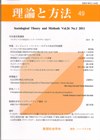Volume 17, Issue 2
Displaying 1-9 of 9 articles from this issue
- |<
- <
- 1
- >
- >|
Special Section : Cluster Analysis and Multidimensional Scaling in Sociology
-
2002 Volume 17 Issue 2 Pages 133-134
Published: October 31, 2002
Released on J-STAGE: February 10, 2009
Download PDF (191K) -
2002 Volume 17 Issue 2 Pages 135-149
Published: October 31, 2002
Released on J-STAGE: February 10, 2009
Download PDF (349K) -
2002 Volume 17 Issue 2 Pages 151-165
Published: October 31, 2002
Released on J-STAGE: February 10, 2009
Download PDF (403K) -
2002 Volume 17 Issue 2 Pages 167-181
Published: October 31, 2002
Released on J-STAGE: February 10, 2009
Download PDF (366K)
Association Prize Acceptance Speech
-
2002 Volume 17 Issue 2 Pages 183-194
Published: October 31, 2002
Released on J-STAGE: February 10, 2009
Download PDF (356K)
Articles
-
2002 Volume 17 Issue 2 Pages 195-209
Published: October 31, 2002
Released on J-STAGE: February 10, 2009
Download PDF (408K) -
2002 Volume 17 Issue 2 Pages 211-226
Published: October 31, 2002
Released on J-STAGE: February 10, 2009
Download PDF (471K)
Seminars : Hands-on Social Research (1)
-
2002 Volume 17 Issue 2 Pages 227-236
Published: October 31, 2002
Released on J-STAGE: February 10, 2009
Download PDF (311K)
Book Reviews
-
2002 Volume 17 Issue 2 Pages 237-251
Published: October 31, 2002
Released on J-STAGE: February 10, 2009
Download PDF (408K)
- |<
- <
- 1
- >
- >|
